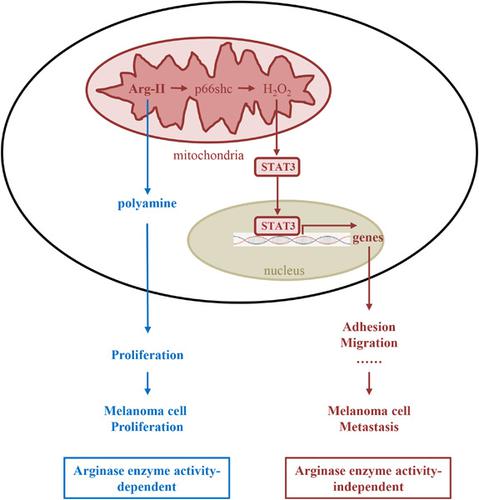当前位置:
X-MOL 学术
›
J. Cell. Physiol.
›
论文详情
Our official English website, www.x-mol.net, welcomes your
feedback! (Note: you will need to create a separate account there.)
Arginase-II promotes melanoma migration and adhesion through enhancing hydrogen peroxide production and STAT3 signaling.
Journal of Cellular Physiology ( IF 4.5 ) Pub Date : 2020-05-29 , DOI: 10.1002/jcp.29814 Yi Yu 1, 2 , Diogo Ladeiras 1 , Yuyan Xiong 1, 2 , Kayluz Frias Boligan 3 , Xiujie Liang 1 , Stephan von Gunten 3 , Robert E Hunger 4 , Xiu-Fen Ming 1 , Zhihong Yang 1
Journal of Cellular Physiology ( IF 4.5 ) Pub Date : 2020-05-29 , DOI: 10.1002/jcp.29814 Yi Yu 1, 2 , Diogo Ladeiras 1 , Yuyan Xiong 1, 2 , Kayluz Frias Boligan 3 , Xiujie Liang 1 , Stephan von Gunten 3 , Robert E Hunger 4 , Xiu-Fen Ming 1 , Zhihong Yang 1
Affiliation

|
Elevated arginase type II (Arg‐II) associates with higher grade tumors. Its function and underlying molecular mechanisms in melanoma remain elusive. In the present study, we observed a significantly higher frequency of Arg‐II expression in melanoma of patients with metastasis than those without metastasis. Silencing Arg‐II in two human melanoma cell lines slowed down the cell growth, while overexpression of native but not a catalytically inactive Arg‐II promoted cell proliferation without affecting cell death. Treatment of cells with arginase inhibitor also reduced melanoma cell number, demonstrating that Arg‐II promotes melanoma cell proliferation dependently of its enzymatic activity. However, results from silencing Arg‐II or overexpressing native or the inactive Arg‐II as well as treatment with arginase inhibitor showed that Arg‐II promotes melanoma metastasis‐related processes, such as melanoma cell migration and adhesion on endothelial cells, independently of its enzymatic activity. Moreover, the treatment of the cells with STAT3 inhibitor suppressed Arg‐II‐promoted melanoma cell migration and adhesion. Furthermore, catalase, but not superoxide dismutase, prevented STAT3 activation as well as increased melanoma cell migration and adhesion induced by overexpressing native or the inactive Arg‐II. Taken together, our study uncovers both activity‐dependent and independent mechanisms of Arg‐II in promoting melanoma progression. While Arg‐II enhances melanoma cell proliferation through polyamine dependently of its enzymatic activity, it promotes metastasis‐related processes, that is, migration and adhesion onto endothelial cell, through mitochondrial H2O2‐STAT3 pathway independently of the enzymatic activity. Suppressing Arg‐II expression rather than inhibiting its enzymatic activity may, therefore, represent a novel strategy for the treatment of melanoma.
中文翻译:

精氨酸酶II通过增强过氧化氢的产生和STAT3信号传导来促进黑色素瘤的迁移和粘附。
升高的II型精氨酸酶(Arg-II)与较高级别的肿瘤有关。它在黑素瘤中的功能和潜在的分子机制仍然难以捉摸。在本研究中,我们观察到转移患者黑色素瘤中Arg-II表达的频率明显高于未转移患者。在两种人黑素瘤细胞系中沉默Arg-II会减慢细胞生长,而天然表达但不是催化惰性的Arg-II的过表达促进细胞增殖而不影响细胞死亡。用精氨酸酶抑制剂处理细胞也可减少黑色素瘤细胞数量,表明Arg-II依赖于其酶促活性促进黑色素瘤细胞增殖。然而,沉默Arg-II或过表达天然或无活性Arg-II的结果以及精氨酸酶抑制剂的治疗结果均表明,Arg-II促进黑素瘤转移相关过程,例如黑素瘤细胞迁移和粘附在内皮细胞上,而与酶活性无关。此外,用STAT3抑制剂处理细胞可抑制Arg-II促进的黑色素瘤细胞迁移和粘附。此外,过氧化氢酶(但不是超氧化物歧化酶)阻止了STAT3的活化以及黑色素瘤细胞迁移和过表达天然或无活性Arg-II诱导的粘附增加。综上所述,我们的研究揭示了Arg-II在促进黑色素瘤进展中的活动依赖性和独立机制。Arg‐II通过多胺增强黑色素瘤细胞的增殖,具体取决于其酶促活性,2 O 2 -STAT3途径与酶活性无关。因此,抑制Arg-II表达而不是抑制其酶促活性可能代表了一种治疗黑色素瘤的新策略。
更新日期:2020-05-29
中文翻译:

精氨酸酶II通过增强过氧化氢的产生和STAT3信号传导来促进黑色素瘤的迁移和粘附。
升高的II型精氨酸酶(Arg-II)与较高级别的肿瘤有关。它在黑素瘤中的功能和潜在的分子机制仍然难以捉摸。在本研究中,我们观察到转移患者黑色素瘤中Arg-II表达的频率明显高于未转移患者。在两种人黑素瘤细胞系中沉默Arg-II会减慢细胞生长,而天然表达但不是催化惰性的Arg-II的过表达促进细胞增殖而不影响细胞死亡。用精氨酸酶抑制剂处理细胞也可减少黑色素瘤细胞数量,表明Arg-II依赖于其酶促活性促进黑色素瘤细胞增殖。然而,沉默Arg-II或过表达天然或无活性Arg-II的结果以及精氨酸酶抑制剂的治疗结果均表明,Arg-II促进黑素瘤转移相关过程,例如黑素瘤细胞迁移和粘附在内皮细胞上,而与酶活性无关。此外,用STAT3抑制剂处理细胞可抑制Arg-II促进的黑色素瘤细胞迁移和粘附。此外,过氧化氢酶(但不是超氧化物歧化酶)阻止了STAT3的活化以及黑色素瘤细胞迁移和过表达天然或无活性Arg-II诱导的粘附增加。综上所述,我们的研究揭示了Arg-II在促进黑色素瘤进展中的活动依赖性和独立机制。Arg‐II通过多胺增强黑色素瘤细胞的增殖,具体取决于其酶促活性,2 O 2 -STAT3途径与酶活性无关。因此,抑制Arg-II表达而不是抑制其酶促活性可能代表了一种治疗黑色素瘤的新策略。











































 京公网安备 11010802027423号
京公网安备 11010802027423号